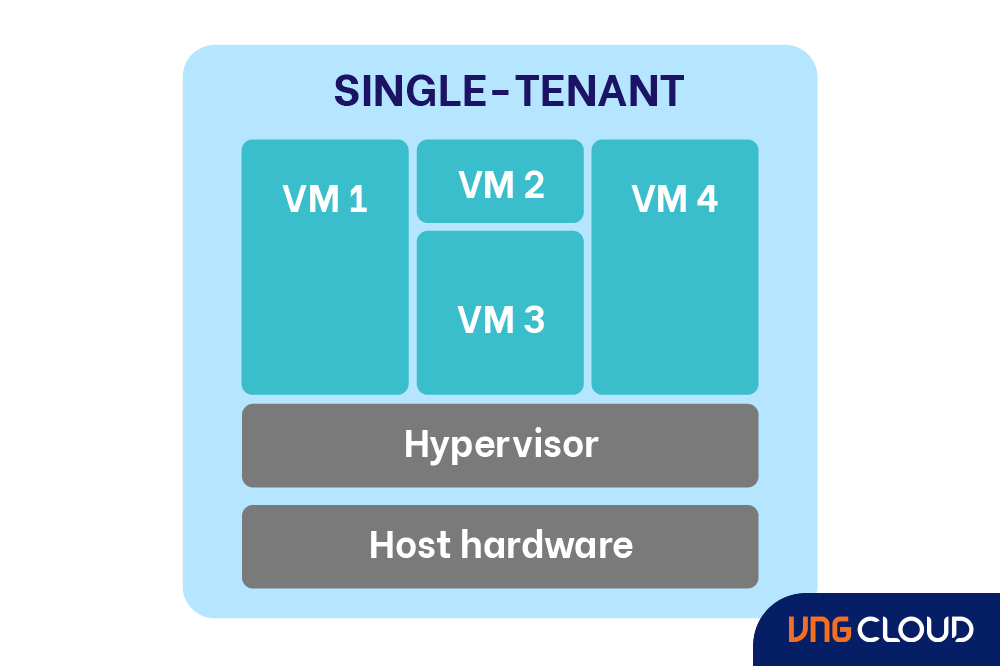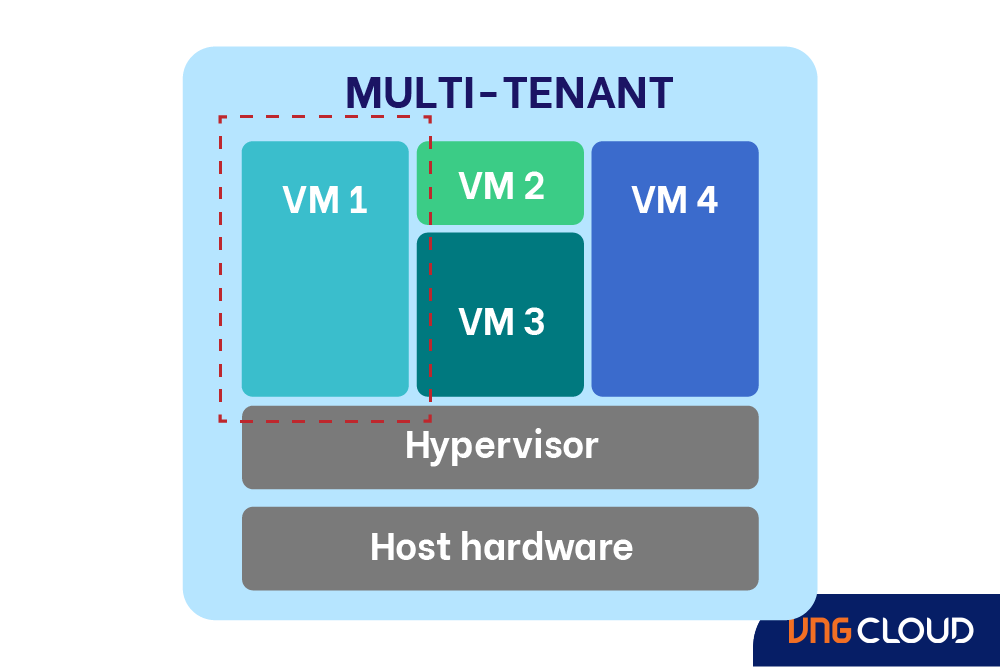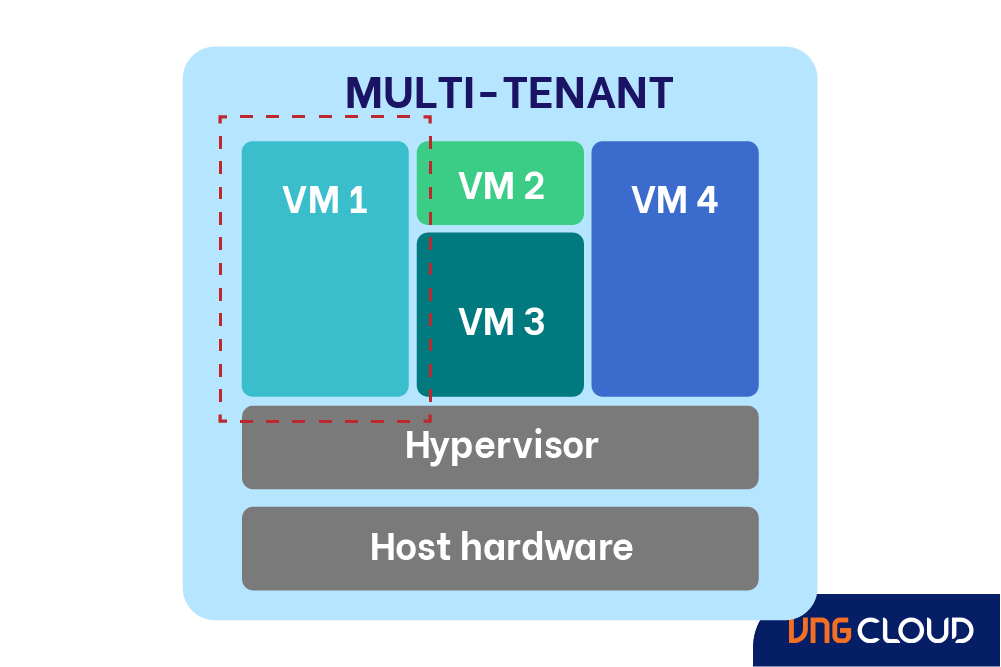When working in the cloud, one of the crucial decisions revolves around selecting the type of architecture suitable for your business and customer data. This choice plays a pivotal role in constructing profitable SaaS software as it directly impacts cost-effectiveness.
Two primary options to contemplate are single-tenant and multi-tenant cloud environments, each carrying its own set of security, privacy, and cost implications. In this article, we will delve into the comparison between multi-tenant and single-tenant cloud architectures and explore strategies for developing cost-effective applications regardless of the chosen model.
What Is Single-Tenant Cloud Architecture?
In SaaS, a single-tenant architecture entails the usage of a single instance of the software application and its accompanying infrastructure to cater exclusively to a single customer, or tenant.
This means that the software's sole instance operates on a dedicated cloud server specifically allocated to serve the needs of this individual customer. Consequently, there is no sharing of resources with any other customers of the SaaS provider.

Single tenancy in cloud computing entails:
- The hosting vendor oversees certain aspects of the dedicated infrastructure and software instance.
- The customer maintains significant control over customizing the software and infrastructure according to their requirements.
- Due to the absence of resource sharing, single tenancy typically offers enhanced confidentiality, security, backup, and performance compared to shared infrastructure.
- Each tenant enjoys their own isolated environment, granting them greater flexibility compared to shared infrastructure models.
However, opting for dedicated service incurs higher costs than utilizing a shared architecture.
What Is Multi-Tenant Cloud Architecture?
A multi-tenant architecture involves a single software instance and its infrastructure being shared among multiple customers (tenants) simultaneously. Although each tenant's data remains isolated from others, all customers share the same database, software application, and SaaS server.

Multi-tenancy in cloud computing entails:
- Physical integration but logical separation of all customers.
- Sharing the same codebase and database among tenants.
- A single instance of the SaaS application serving multiple customers concurrently on a single server.
- Each tenant has some degree of customization for database schemas, UI colors, and application rules, with the hosting provider retaining significant control over the SaaS infrastructure.
- Leveraging economies of scale to reduce operational costs compared to dedicated environments.
- Prioritizing scalability, offering virtually limitless computing capacity.
What Is A Mixed Tenancy Model?
In the mixed tenancy approach, a cloud provider allocates one or more segments of the application as dedicated to each client, while sharing the remainder among all customers.
Cloud providers are increasingly adopting a hybrid model that combines elements of single-tenancy and multi-tenancy. With this approach, customers can leverage the scalability and cost advantages of multi-tenancy while also enjoying the isolation and dedicated resources of single-tenancy architecture.

SSingle-Tenant Vs. Multi-Tenant Cloud Architecture
The analogy often used to illustrate single-tenant versus multi-tenant cloud architecture is akin to real estate.
In a single-tenant cloud architecture, each customer resides in their own standalone apartment building, equipped with its own security system and amenities, ensuring complete isolation from neighboring buildings.
On the other hand, in a multi-tenant cloud architecture, tenants occupy different units within a single apartment building. While they share the same security system and communal facilities, each tenant holds a key to their individual unit, ensuring privacy within their space. However, the actions of fellow tenants may affect their overall comfort within the building.
Many startups choose a multi-tenant setup, wherein all customer data is stored in a single large database. Despite sharing the same database, customer data remains private with the implementation of robust security measures. Although customers cannot access each other's data, they coexist within the same database, processed by the same computer, without segmentation.
Pros and Cons of Single-Tenant Cloud Architecture
Advantages of single-tenant cloud architecture include:
- Enhanced data security: Each customer's data is segregated, reducing the risk of widespread data breaches.
- Increased customization: Single-tenant systems offer greater customization options as each customer has dedicated software and hardware.
- Improved portability: Migrating data from a single-tenant architecture is often simpler due to the smaller data volume and reduced complexity.
- Simplified migration: Since the data store exclusively houses data for a single customer, migration concerns are minimized, and the process is akin to setting up a new customer.
Disadvantages of single-tenant cloud architecture include:
- Complex setup and management: Deploying and managing instances and databases for each customer can become challenging, especially as the customer base expands. This complexity is particularly burdensome for small startup teams.
- Higher costs: Operating a single-tenant setup is more costly than utilizing shared resources. Maintaining dedicated databases and computing resources for each customer requires substantial resources.
- Inefficient resource usage: Resources are often underutilized, leading to inefficiencies. Due to varying usage patterns among customers, allocating the same resources to each customer may result in some using all or more of their allocation while others use minimal resources.

Pros and Cons of Multi-Tenant Cloud Architecture
Some benefits of multi-tenant cloud architecture include:
- Streamlined deployment: For small startup teams, deploying and serving multiple clients using a single-tenant approach can be labor-intensive. However, with a multi-tenant system, leveraging tools provided by cloud service providers like VNG Cloud enables faster application development.
- Efficient resource usage: In contrast to single-tenant models where resources may be underutilized, multi-tenant environments maximize resource usage as they are shared among multiple users.
- Cost-effectiveness: Multi-tenancy distributes the environment's cost among multiple customers, making application development and maintenance more economical. Shared maintenance and management costs help reduce expenses. For instance, a single DynamoDB Table can efficiently accommodate data for millions of customers.
While multi-tenant cloud architecture is often preferred for consumer-facing applications, it has drawbacks, including:
- Increased security risks: Sharing resources among multiple customers in a multi-tenant system elevates security concerns. Compromising one customer's data poses a greater risk of affecting other customers, unlike in a single-tenant cloud where security incidents are contained to a single client.
- Cost visibility challenges: Unlike single-tenant systems where each customer has their dedicated database, separating costs in a multi-tenant setup can be more complex and less transparent. However, this can be improved by using cost control tools (such as vConsole) provided by the cloud service provider.
When To Use Single-Tenant Vs. Multi-Tenant Architecture?
A single-tenant architecture is often preferred in industries like healthcare and finance, where stringent privacy and security regulations govern customer data handling. For instance, certain financial data requires dedicated infrastructure to meet regulatory standards.
Conversely, multi-tenant architectures are typically ideal for consumer-facing applications. Cloud service providers use multi-tenant infrastructures where the same hardware serves multiple customers. Although each customer maintains a distinct Cloud account, their data is processed on the same computers.
Cloud Migration with VNG Cloud
VNG Cloud caters to the specific needs of businesses by offering many cloud architectures. Whether organizations require dedicated resources for enhanced privacy and control or seek cost-effective shared infrastructure for scalability, we provide tailored options to suit your requirements.
Some of our notable products:
- vServer: Smart cloud server system.
- vStorage: Multi-tier cloud storage solution.
- vMonitor Platform: Comprehensive cloud monitoring solution.
- vConsole Portal: Effective cloud cost control & management.
Register for the free trial and enjoy a favorable experience on our cloud platform, such as:
- Create and manage cloud resources on the VNG Cloud’s self-service portal.
- Build and deploy container applications in the cloud.
- Track your performance reports and statistics in real-time.
- Effective Identity & Access Management for cloud resources.
- Experience integrations and other advanced services.
By offering flexibility in architecture, coupled with stringent security measures and reliable support, VNG Cloud ensures that your businesses can confidently navigate their cloud journey while meeting their specific needs and compliance requirements.